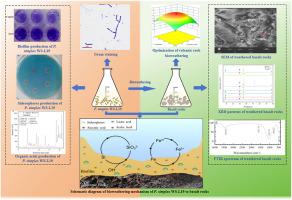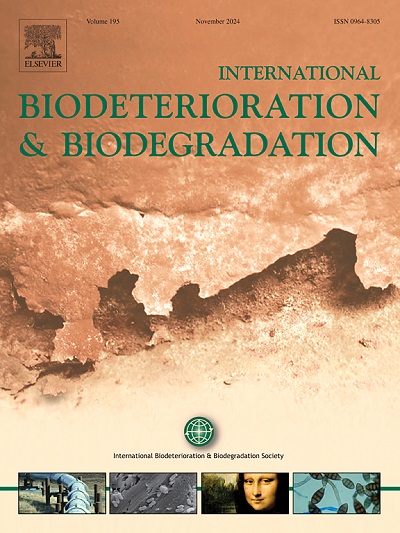Basalt rock weathering by Peribacillus simplex from Wudalianchi volcanos in NE China and implications for Fe and Si biogeochemical cycling
IF 4.1
2区 环境科学与生态学
Q2 BIOTECHNOLOGY & APPLIED MICROBIOLOGY
International Biodeterioration & Biodegradation
Pub Date : 2024-11-02
DOI:10.1016/j.ibiod.2024.105948
引用次数: 0
Abstract
Bacteria have an important role in weathering the different rocks, but little is known about the mechanism of microbial weathering in basalt rocks. In the present study, Peribacillus simplex WS-L19 isolated from Wudalianchi volcanos exhibits the highest Fe and Si rock dissolution, which revealed unique weathering ability. The optimal weathering conditions of LB medium diluted at 30.9%, the rotation speed of 127.2 rpm, and temperature at 36.6 °C, resulted in the Fe and Si releases of 1.70 ± 0.09 μg/mL and 20.11 ± 1.13 μg/mL, respectively. Simultaneously, complex ligands such as organic acids (tartaric acid, formic acid, lactic acid and succinic acid), siderophores, and biofilm were also found to be involved in weathering processes by P. simplex WS-L19. Kinetics study of Fe and Si release indicated that the weathering processes of volcanic rocks mediated by P. simplex WS-19 fits a Hyperbl model. Mineralogical analysis showed a decrease in Fe releasing ratio by 44.65% and an increase in Si releasing ratio by 28.45%, showing that Fe is more accessible than Si. P. simplex WS-L19 had a significant weathering effect on biotite, and Si-O bonding vibration might contribute to weathering. The results suggest that indigenous P. simplex WS-L19 plays a role in weathering Wudalianchi volcanos and provides new insights into the Fe and Si biogeochemical cycling of basalt rocks.

中国东北五大连池火山的玄武岩岩石风化及对铁和硅生物地球化学循环的影响
细菌在不同岩石的风化过程中发挥着重要作用,但人们对玄武岩微生物风化的机理知之甚少。在本研究中,从五大连池火山中分离出的单纯弧菌 WS-L19 对岩石中铁和硅的溶解度最高,显示了其独特的风化能力。在稀释度为 30.9% 的 LB 培养基、转速为 127.2 rpm、温度为 36.6 °C 的最佳风化条件下,Fe 和 Si 的释放量分别为 1.70 ± 0.09 μg/mL 和 20.11 ± 1.13 μg/mL。与此同时,还发现有机酸(酒石酸、甲酸、乳酸和琥珀酸)、嗜硒体和生物膜等复合配体也参与了单纯栉水母 WS-L19 的风化过程。铁和硅释放动力学研究表明,单胞菌 WS-19 介导的火山岩风化过程符合 Hyperbl 模型。矿物学分析表明,铁的释放率降低了 44.65%,而硅的释放率提高了 28.45%,这表明铁比硅更容易获得。单胞菌 WS-L19 对黑云母有明显的风化作用,Si-O 键振动可能有助于风化。研究结果表明,本地单胞菌 WS-L19 在五大连池火山风化过程中发挥了作用,并为玄武岩中铁和硅的生物地球化学循环提供了新的见解。
本文章由计算机程序翻译,如有差异,请以英文原文为准。
求助全文
约1分钟内获得全文
求助全文
来源期刊
CiteScore
9.60
自引率
10.40%
发文量
107
审稿时长
21 days
期刊介绍:
International Biodeterioration and Biodegradation publishes original research papers and reviews on the biological causes of deterioration or degradation.

 求助内容:
求助内容: 应助结果提醒方式:
应助结果提醒方式:


